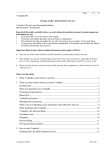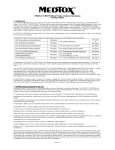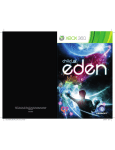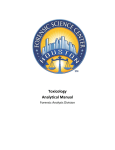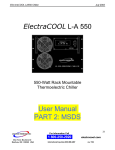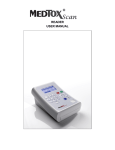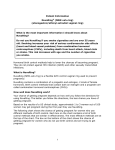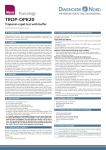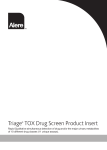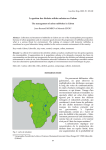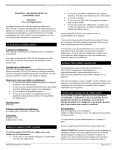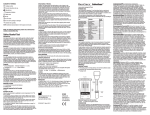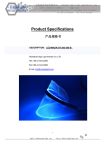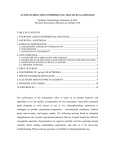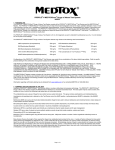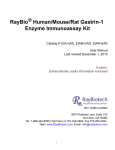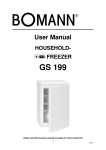Download User Manual - Diagnostik Nord
Transcript
synCAN-S20 Synthetische Cannabinoide Drug Screen Test For medical and other professional in vitro diagnostic use only. INTENDED USE The Diagnostik Nord Synthetische Cannabinoide Drug Screen Test is a lateral flow immunoassay for the specific, qualitative detection of synthetic cannabinoids metabolites in human urine at a cut-off level of 30ng/mL. The synthetic cannabinoids detected by the test include, but are not limited to, the metabolites of JWH-018 and JWH-073. This assay provides only a preliminary result. Careful consideration and professional judgment must be applied to any drug of abuse test result, particularly in evaluating a preliminary positive result. In order to obtain a confirmed analytical result, a more specific alternate chemical method is needed. Liquid Chromatography/Mass Spectrometry (LC/MS) is the preferred confirmation method. SUMMARY AND EXPLANATION Synthetic Cannabis is a family of compounds that when consumed mimics the effects of Marijuana. It is also known by the brand names of K2 and Spice, both of which have largely become trademarks used to refer to any synthetic cannabinoids product. Studies suggest that synthetic cannabinoid intoxication is associated with acute psychosis, and the worsening of previously stable psychotic disorders among vulnerable individuals such as those with a family history of mental illness. JWH-018 and JWH-073 are the primary synthetic cannabinoid receptor agonists responsible for the euphoric and psychoactive effects that imitate Marijuana and are among the numerous compounds found in “herbal” incense or smoke blends. Most popular herbal smoking products are marketed under the brand names of K-2, K-3, Spice, Genie, Black Mombo, Pot-pouri, Buzz, Pulse, Hush, Mystery, Earthquake, Ocean Blue, Stinger, Yucatan Fire, as well as many others. TEST PRINCIPLE The Diagnostik Nord Synthetische Cannabinoide Drug Screen Test is based on the principle of competitive immunochemical reaction between a chemically labeled drug (drugprotein conjugate) and the drug or drug metabolites which may be present in the urine sample for the limited antibody binding sites. The test contains a nitrocellulose membrane strip pre-coated with drug-protein conjugate in the test region and a pad containing colored antibody-colloidal gold conjugate. During the test, the urine sample migrates upward and rehydrates the antibody-colloidal gold conjugate. The mixture then migrates along the membrane chromatographically by the capillary action to the immobilized drug-protein band on the test region. When drug is absent in the urine, the colored antibody-colloidal gold conjugate and immobilized drug-protein bind specifically to form a visible line in the test region. When drug is present in the urine, it will compete with drugprotein for the limited antibody sites. The line on the test region will become less intense with increasing drug concentration. When a sufficient concentration of drug is present in the urine, it will fill the limited antibody binding sites. This will prevent attachment of the colored antibody-colloidal gold conjugate to the drug-protein on the test region. Therefore, the presence of the line on the test region indicates a negative result for the drug and the absence of the test line on the test region indicates a preliminary positive result for the drug. A visible line generated by a different antigen/antibody reaction is also present at the control region of the test strip. This line should always appear, regardless of the presence of drugs or metabolites in the urine sample. This means that a negative urine sample will produce both test line and control line, and a positive urine sample will generate only control line. The presence of control line serves as a built-in control, which demonstrates that the test is performed properly. WARNINGS AND PRECAUTIONS •U rine specimens and used cards may be potentially infectious. Proper handling and disposal methods should be established. • This is a single use test. • Avoid cross-contamination of urine samples by using a new specimen collection container for each urine sample. • The test card should remain sealed in the foil pouch until ready for use. • Do not use the test kit after the expiration date. STORAGE The Diagnostik Nord Synthetische Cannabinoide Drug Screen Test should be stored at 2 – 30°C (36 – 86°F) in the original sealed pouch. Do not freeze. Do not store and/or expose reagent kits to a temperature greater than 30°C. SPECIMEN COLLECTION AND HANDLING Fresh urine does not require any special handling or pretreatment. A clean, dry plastic or glass container may be used for specimen collection. If the specimen will not be tested immediately after the collection, the specimen may be refrigerated at 2-8°C up to 3 days or frozen at -20°C for longer a period of time. Specimens that have been refrigerated must be equilibrated to room temperature prior to testing. Specimens previously frozen must be thawed and mixed thoroughly prior to testing. Note: U rine specimens and all materials coming in contact with them should be handled and disposed as if capable of transmitting infection. Avoid contact with skin by wearing gloves and proper laboratory attire. ASSAY PROCEDURE FOR DRUG TEST Preparation 1. If the specimen, control, or test cards have been stored at refrigerated temperatures, allow them to warm to room temperature before testing. 2.Do not open test card pouch until ready to perform the test. Testing 3. Remove the card test from the sealed pouch. Write donor name or ID on the plastic. Remove the cap to expose the sampling tips.(Illus. 1) 4. Immerse the sampling tip into the urine specimen for approximately 15 – 30 seconds. Do not allow specimen to come in contact with the plastic housing. Replace the cap over the sampling tip and then place the test card on a flat surface. (Illus. 2) 5. R ead results of drugs of abuse tests in 5 minutes. Do not interpret result after 60 minutes. Refer to interpretation of results section. MATERIALS Materials Provided • 20 individually wrapped test cards. Each card consists of a test strip in a plastic test strip holder. The test strip contains a colloidal gold pad containing coated drug-targeted antibody and rabbit antibody. It also contains a membrane coated with drugprotein conjugate in the test band and goat anti-rabbit antibody in the control band region. • One instruction sheet Materials Required but not Provided • Timer • Specimen collection container • External positive and negative controls Fig. 1 Fig. 2 INTERPRETATION OF RESULTS INTERFERENCE POSITIVE A colored line appears in the control region and no colored line appears at a specific drug test region. The complete absence of a test line indicates a preliminary positive result for that particular drug. A preliminary positive result for a drug indicates that the concentration of that drug in the urine is at or above the cutoff level. negativE A colored line appears at the control region (C) and a colored line appears at a specific drug test region (T). The appearance of a control line and test line indicates a negative test result. The test lines may have varying intensity either weaker or stronger in color than that of the control line. INVALID No colored line appears in the control region. If the control line does not form, the test result is inconclusive and should be repeated. qUALITY CONTROL An internal procedural control is included in the test card. A line must form in the Control band region regardless of the presence or absence of drugs or metabolites. The presence of the line in the Control region indicates that sufficient sample volume has been used and that the reagents are migrating properly. If the line in the Control region does not form, the test is considered invalid and must be repeated. To ensure proper kit performance, it is recommended that the Diagnostik Nord Synthetische Cannabinoide Drug Screen Test cards be tested using external controls with each new lot of product and each new shipment. External controls are available from commercial sources. Additional testing may be necessary to comply with the requirements accrediting organizations and/or local, state, and/or federal regulators. LIMITATIONS OF PROCEDURE • The assay is designed for use with human urine only. • A positive result with the test indicates only the presence of a drug/metabolite and does not indicate or measure intoxication. • There is a possibility that technical or procedural errors as well as other substances present in the urine sample may interfere with the test and cause false results. See SPECIFICITY and INTERFERENCE for lists of substances that will produce positive results and those that do not interfere with test performance. • If adulteration is suspected, the test should be repeated with a new sample. PERFORMANCE CHARACTERISTICS A. Accuracy The accuracy of the Diagnostik Nord Synthetische Cannabinoide Drug Screen Test was evaluated in comparison to liquid chromatography/tandem mass spectrometry (LC/ MS-MS). Eighty-seven (87) specimens, comprised of 43 negative urine samples and 44 positive urine samples, were blinded and tested with the Diagnostik Nord Synthetische Cannabinoide Drug Screen Test and compared to the LC/MS-MS results. The testing showed a >95% agreement between the two methods. B. Precision A study was conducted in an effort to determine the precision of the Diagnostik Nord Synthetische Cannabinoide Drug Screen Test. Testing was conducted using three different lots of product to demonstrate the within-run and between-run precision. The correlation with expected results for the solutions targeted to +/-50% of the cutoff was > 99% across all lots. C. Specificity The specificity for the Diagnostik Nord Synthetische Cannabinoide Drug Screen Test was determined by evaluating the performance of assay when tested with various drugs, drug metabolites, and other compounds that are likely to be present in urine. All compounds were prepared in drug-free normal human urine. The following compounds produce positive results when tested at levels greater than the concentrations listed: performance features Compound Conc. (ng/mL) JWH-018 Pentanoic Acid 30 JWH-073 Butanoic Acid 15 JWH-018-N-4-Hydroxypentyl 200 JWH-073-N-4- Hydroxybutyl 300 JWH-081-N-5- Hydroxypentyl 1000 JWH-200-N-6-Hydroxyindole 300 AM-2201-N-4-Hydroxypentyl 1000 JWH-250-N-5-Hydroxyindole 300 RCS-4-N-5- Carboxypentyl 250 Lamotrigine 50 The following compounds were evaluated for potential positive and/or negative interference with the Diagnostik Nord Synthetische Cannabinoide Drug Screen Test. All compounds were dissolved in a Drug-free control solutions and tested with Diagnostik Nord Synthetische Cannabinoide Drug Screen Test. An unaltered sample was used as a control. No positive interference or negative interference was found for the following compounds when tested at concentrations up to 100 μg/ml. Acetaminophen, Acetone, Acetylsalicylic acid, Albumin, Amitriptyline, Amobarbital, Amphetamine, Ampicillin, Ascorbic Acid, Atropine Sulfate, Benzocaine, Benzoylecgonine HCL, Bilirubin, Bup-3-B-glucuronide, Buprenorphine, Butalbital, Caffeine, Cannabidiol, Cannabinol, Chloroquine, (+)-Chlorpheniramine, (+/-)-Chlorpheniramine, +/- CP 47,497, Cocaine, Codeine, Cotinine, Creatine, Delta-8-tetrahydrocannabinol, Dexbrompheniramine, Dextromethorphan, Dextrose, Diazepam, 4-Dimethylaminoantipyrine, Diphenhydramine, Dopamine, Ecgonine HCL, Ecgonine Methyl Ester, EDDP, Efavirenz, Ephedrine, (+/-)-Epinephrine, Erythromycin, Ethanol, Furosemide, Glucose, Hemoglobin, Hippuric acid, Hydrocodone, Hydromorphone, HU-211, Ibuprofen, Immipraime, (+/-)-Isoproterenol, 11-hydroxy-delta-9-THC, 11-nor-Δ9-THC-9-COOH, Ketamine, Lansoprazole, Lidocaine, MDA, MDMA, Methadone, Methamphetamine, Morphine Sulfate, Myoglobin, Nalophine,Niacinamide, Nicotine, Nortriptyline, Omeprazole, Oxalic Acid, Oxycodone, Oxymorphone, Oxazepam, Pantoprazole, Penicillin-G, Pentobarbital, Pheniramine, d-Propoxyphene, Phencyclidine, Phenylephrine, ß-Phenylethylamine, Procaine, Pseudoephedrine, Quinidine, Ranitidine, Riboflavin, RSC-4-N-5-hydroxypentyl, Secobarbital, Sodium Chloride, Sulindac, Theophylline, Trimipramine, Tyramine, Urea Effect of Specimen pH Drug-free sample solutions were adjusted to pH 4 – 9 and tested using Diagnostik Nord Synthetische Cannabinoide Drug Screen Test. An unaltered sample was used as a control. The results demonstrate that varying ranges of specimen pH do not interfere with the performance of the test. Effect of Specimen Specific Gravity Drug-free sample solutions were adjusted to specific gravity 1.000 – 1.030 and tested using Diagnostik Nord Synthetische Cannabinoide Drug Screen Test. An unaltered sample was used as a control. The results demonstrate that varying ranges of specimen specific gravity do not interfere with the performance of the test. Literature 1. InfoFacts-Club drugs, NIDA, May 2006, http://www.nida.nih.gov/infofacts/clubdrugs.html 2. Drug Fact Sheet, DEA, January 2012, http://www.dea.gov. Index of Symbols n Content For in-vitro diagnostic use only Lot number For single use only Expiry date Carefully read package insert Store at room temperature Rev.: 27.08.2014 (JM) ersetzt 25.03.2014 (JM) – 42131-DN Rev. 0 Producer Diagnostik Nord GmbH Mecklenburgstraße 97 19053 Schwerin Germany Telefon: Fax: E-Mail: Internet: +49 (0) 385 208 409-0 +49 (0) 385 208 409-29 [email protected] www.diagnostik-nord.de


